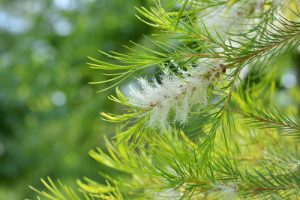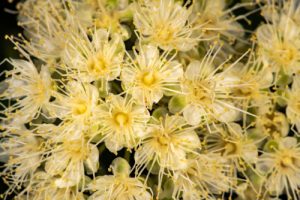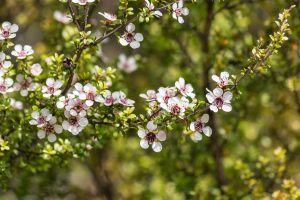Nature’s Miracle Mantras July 30, 2020
The Australian Power House
All of us are wishing for a miracle medicine or ingredient. It is heartening that there are several plant essences that are no less than nature’s miracle mantras for keeping us clean and hygienic. Essential oils work wonders to strengthen immunity and instil mood-boosting wellness. Some of them have proven to have significant germ-repellent properties; and in times like these, that is quite a bonus.

Expanding volumes of research over the past and recently, spurred by our current global health situation, has rekindled interest in anti-microbial agents. This has, of course, opened a can of worms or, quite literally, bacteria. Since the scrutiny of numerous gram-negative and gram-positive bacteria, viruses and fungi is now more intense than ever. For a long time, it has been a struggle to devise antibodies to the more deadly, multi-layered, gramnegative bacteria with its protective peptidoglycan membrane and high lipid profile. The complexity remains in being unable to destroy cell membranes while the bacteria evolve to develop resistance to antibiotics. On the contrary, most-gram positives respond to treatment with antibodies and as such usually result in lesser havocs. Of course, non-pathogenic micro-biomes of the human skin, intestine, and respiratory tracts are critical to a healthy existence and some are even used in food applications. Did you know that that delectable, heavenly Emmental or Gruyère cheese, favourite of many, get their distinct flavours from cultures of Streptococcus, Lactobacillus or Propionibacterium? While you chew on that we take this opportunity to look at some of the key anti-microbial essential oils that are good to have in your arsenal.
The history of healing traces back to the Australian aborigines who crushed tea tree leaves to treat coughs and colds and as a poultice for wounds. Folklore even speaks of the waters of healing lakes; the tea tree leaves which fell into the lake decayed, decomposed and turned the water into healing potions.
TEA TREE OIL
Tea tre e oil is indeed a part of a very old legacy. Revered by indigenous populations Melaleuca alternifolia has curried favour for generations as an amazing therapeutic. Australia boasts an annual production of almost 700 MT in plantations spread across New South Wales and Northern Queensland.
e oil is indeed a part of a very old legacy. Revered by indigenous populations Melaleuca alternifolia has curried favour for generations as an amazing therapeutic. Australia boasts an annual production of almost 700 MT in plantations spread across New South Wales and Northern Queensland.
Production
Leaves and terminal branchlets yield a colourless to pale yellow oil with a strong, warm scent with spicy-earthy notes. The sturdy plant is resilient and regenerates swiftly provided a robust root network is established. Sometimes to the detriment of the oil quality, the new growth trees yield a higher 1,8-cineole content. This is usually avoided by following a replanting cycle after every 6 to 7 years. The seed-to-harvest period is around a year to 15 months with the tree attaining an average height of 2 metres. Taking care to trim it a few inches above the ground, the tree is harvested from May to November.
Constituents
- 35 to 48% terpinen-4-ol, the super stimulant of white blood cells and anti-microbial activity
- 1,8-cineole (less than 10%)
- Globulol
- Limonene
- α-terpinene
- α-terpineol
Benefits & Uses
The history of healing traces back to the Australian aborigines who crushed tea tree leaves to treat coughs and colds and as a poultice for wounds. Folklore even speaks of the waters of healing lakes; the tea tree leaves which fell into the lake decayed, decomposed and turned the water into healing potions. Today its versatility as an anti-fungal, anti-bacterial and anti-microbial, and anti-inflammatory agent is unparalleled. It is used in freshening laundry, as an insect repellent, hand sanitizer, carpet and all-purpose household cleaner, in deodorants and preparations for colds, flu, bronchitis, whooping cough and sinusitis. A few drops are enough to banish dandruff, head lice, herpes, athlete’s foot or contact dermatitis, acne, gingivitis, psoriasis, and minor cuts and bruises.
Look out for: Old stocks of tea tree oil. The oil oxidises easily so any stock stored over time might end up causing skin irritation.
EUCALYPTUS OIL
 What do we and koala bears have in common? Our undying love for eucalyptus! With over 700 species, this Myrtaceae family has been part of Australian history for as long as anyone can remember. Ancient Chinese, Indian, and Greek civilisations refer to eucalyptus as a go-to treatment for a host of ailments. Eucalyptus radiata, popularly known as the narrow-leaved peppermint, abounds across the continent but is processed primarily in New South Wales while its smaller, mallee type cousin Eucalyptus horistes prefers the soil of Western Australia. Eucalyptus globulus, also known as Blue Gum, is also another favoured oil-yielding species.
What do we and koala bears have in common? Our undying love for eucalyptus! With over 700 species, this Myrtaceae family has been part of Australian history for as long as anyone can remember. Ancient Chinese, Indian, and Greek civilisations refer to eucalyptus as a go-to treatment for a host of ailments. Eucalyptus radiata, popularly known as the narrow-leaved peppermint, abounds across the continent but is processed primarily in New South Wales while its smaller, mallee type cousin Eucalyptus horistes prefers the soil of Western Australia. Eucalyptus globulus, also known as Blue Gum, is also another favoured oil-yielding species.
Production
During April till November leaves and terminal branches of these tall, majestic-looking trees are harvested and sent for processing. These are then dried, crushed, and steam9 distilled to extract the essential oil, which is a colourless, clean-scented oil with fresh-feel, camphorous notes and slight hints of citrusy-floral overtones.
Constituents
- At least 70% or more of 1,8-cineole or eucalyptol
- α-pinene
- β-pinene
- α-phellandrene
- sabinene
- camphene
- limonene
- citronellal
Benefits & Uses
From medicines to cosmetics and perfumes to cleaners, eucalyptus oil is a multitasker. It is an anti-viral, antibacterial, anti-inflammatory bronchodilator. Add a few drops to your diffuser for that invigorating mood enhancement, relieving blocked sinuses or clearing that irritating cough. Its inherent anti-microbial nature reduces bacteria and contact infection makes it an invaluable ingredient in insect repellent, household and industrial cleaners and disinfectants. Its immunity-enhancing and healing qualities give it a pivotal role in aromatherapy, dermal inflammation, and respiratory distress. Eucalyptus is a key ingredient in throat sprays, mouthwashes, inhalers, personal care items, chest rubs, and topical pain relievers.
Look out for: Blending this very potent oil with other carrier oils. Partners perfectly with coconut, olive, avocado, argan and jojoba oils.
LEMON MYRTLE OIL
 Not only can you heal with this wonderful leaf, but you can cook and eat it too! That’s exactly what some of the original settlers of Australia have been using lemon myrtle for. Free and easy-growing, the native Backhousia citriodora is actually a tropical rainforest tree. Its creamywhite clusters of flowers make it a favourite ornamental hedge and garden tree. This is an evergreen tree that grows tall and flourishes in the warm, humid climes of central and south-eastern Queensland. Commercially, it is now grown in plantations around the Northern Rivers area. Lemon-scented myrtle leaves are a powerhouse of fragrance and flavour. They are a customary flavouring ingredient while dried leaves are used as spice or distilled for oil.
Not only can you heal with this wonderful leaf, but you can cook and eat it too! That’s exactly what some of the original settlers of Australia have been using lemon myrtle for. Free and easy-growing, the native Backhousia citriodora is actually a tropical rainforest tree. Its creamywhite clusters of flowers make it a favourite ornamental hedge and garden tree. This is an evergreen tree that grows tall and flourishes in the warm, humid climes of central and south-eastern Queensland. Commercially, it is now grown in plantations around the Northern Rivers area. Lemon-scented myrtle leaves are a powerhouse of fragrance and flavour. They are a customary flavouring ingredient while dried leaves are used as spice or distilled for oil.
Constituents
- Most of it is citral around 87 to 95% which gives the zesty lemon aroma
- Myrcene
- Linalool
- methyl heptenone
- citronella
- geranial
- trans-geraniol
- lutein
Benefits & Uses
Giving lemon oil a run for its money, this ‘Queen of lemon herbs’ is among the original bushfoods to make a firm place in the culinary galaxy. As an epicurean flavouring this highly aromatic herb is used in a plethora of culinary staples, as well as a deterrent for food spoilage, especially in milk-based edibles. It is a strong surface disinfectant; and its anti-viral, anti-fungal properties are put to use in medicines, skincare products, perfumery, insect repellents and surface and household cleaners. It has been especially useful in curing Molluscum contagiosum, athlete’s foot, arthritis, headaches, asthma, and healing cuts and wounds. In aromatherapy, it relieves stress and eases depression.
Look out for : Fresh or dried leaves are an excellent substitute for kaffir lime, but if you’re using oil, do follow ratios strictly.
Prized for its anti-bacterial qualities and the wonderful woody-balsamic aroma, blue cypress oil is a double health elixir.
BLUE CYPRESS OIL
 A truly unique “blue” to drive away all your blues. The blue cypress tree is another Australian native that was used extensively by the Tiwi population of Melville and Bathurst islands. This coniferous Callitris intratropica from the Cupressaceae family grows wild in the Northern Territory, in the Kakadu region, Cape York of Queensland and Kimberley in Western Australia. Sturdy and termite resistant, the tree was popular for construction but now enjoys sustainability under government aegis. It grows extremely slowly and boasts longevity of almost 200 years.
A truly unique “blue” to drive away all your blues. The blue cypress tree is another Australian native that was used extensively by the Tiwi population of Melville and Bathurst islands. This coniferous Callitris intratropica from the Cupressaceae family grows wild in the Northern Territory, in the Kakadu region, Cape York of Queensland and Kimberley in Western Australia. Sturdy and termite resistant, the tree was popular for construction but now enjoys sustainability under government aegis. It grows extremely slowly and boasts longevity of almost 200 years.
Production
All year the unbarked logs of the tree are collected. These are then resized into smaller pieces, sometimes shavings or chips. Eventually these are steam-distilled slowly over 48 hours. The striking deep cobalt blue oil exudes a distinctive woody, earthy aroma with spicy-floral notes.
Constituents
- Guaiol formed during distillation imparts not just the brilliant colour but anti-inflammatory properties too
- Guaiazulene
- Bulnesol
- gamma-Eudesmol
- β -Eudesmol,
- α-Eudesmol
- dihydrocolumellarin
Benefits & Uses
Prized for its anti-bacterial qualities and the wonderful woody-balsamic aroma, blue cypress oil is a double health elixir. In cosmetics and as a perfume fixative, it soothes away stress with positive mood elevation in addition to its excellent anti-inflammatory and anti-viral properties. A go-to oil for perking up one’s emotional quotient and enlivening mood, improving immunity, skin-breaks, respiratory health, insect bites, and dermal burns, arthritis, asthma relief.
Look out for: Some of the floral oils like rose or ylang ylang to pair and experience a mental spa.
MANUKA OIL
 The secret of Maori health is inextricably intertwined with manuka. Highly adaptable, the Leptospermum scoparium from New Zealand varies between a creeper to growing as upright as 8 metres tall. Going by the local moniker of Kahikatoa, its antiseptic potency overrides those of tea tree oil by up to 30 times.
The secret of Maori health is inextricably intertwined with manuka. Highly adaptable, the Leptospermum scoparium from New Zealand varies between a creeper to growing as upright as 8 metres tall. Going by the local moniker of Kahikatoa, its antiseptic potency overrides those of tea tree oil by up to 30 times.
Production
The oil-rich leaves and terminal branches are harvested, mulched and subjected to steam distillation for oil extraction. Harvest is conducted mechanically or by hand to encourage regrowth; and the raw material is left to dry before packing into a still. After boiling the steam is passed through a condenser, where it turns back to water, collected and the essential oil is siphoned off. The oil exudes a distinct light, herbaceous yet sweet aroma.
Constituents
- ß-triketones like leptospermone that makes it one of nature’s superpower antimicrobials
- trans-calamenene
- α-copaene
- cadinene
- cadina-1,4-diene
- antioxidants
Benefits & Uses
Nature’s miracle oil for skin, manuka works as an effective anti-fungal, anti-bacterial and anti-histaminic. An excellent skin emollient found in most skincare products, it also soothes inflammation from joint pains, sunburn, insect bites. As a cicatrizant and a cytophylactic, it speeds up wound healing and treats fungal infections, skin disorders such as eczema, psoriasis, and age-related conditions. Manuka is also widely used in aromatherapy for its calming influence.
Look out for: In our ever-mutating world the road to wellness leads through ditching the diseases and taking meticulous care in keeping our environments clean and germ-free. Nature has the means. We just need to find them and remember to use them responsibly.
 Ultra International B.V.
Ultra International B.V.